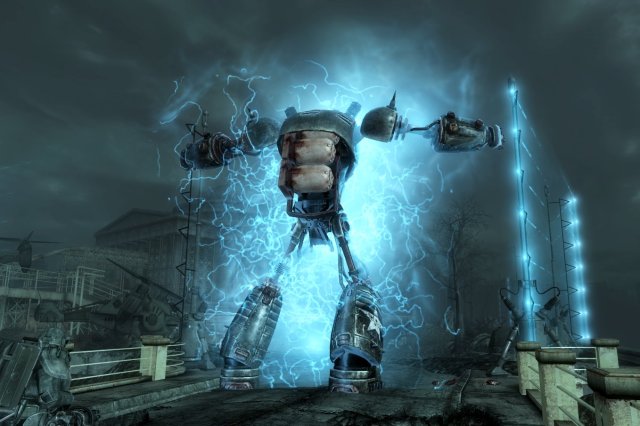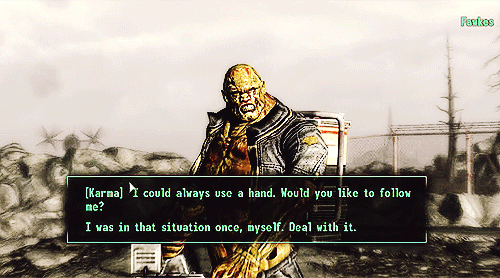
When I first played Fallout 3 on my Xbox 360 way back in 2008, I found myself drawn to the hubs and the quests. Exploring the wasteland was fun, but ultimately I was looking for structure and a story. I’ve recently booted up Fallout 3 again, but this time on the PC. With extreme (but lore friendly) modding, I’ve found the exploration aspect far more enjoyable and the quests frankly lackluster. I want to deconstruct the quests in Fallout 3 to think about how they work in relation to an open world map and the player character’s development choices.
Let’s start with the basics. Not counting the three childhood quests, Fallout 3 has a total of 66 quests in the base game: 10 story quests, 18 side quests, 22 unmarked side quests, and 16 repeatable fetch quests. Again, I want to briefly break down each of these to see how they’ve made use of the new environment and the RPG elements. We’ll start with the story quests.
Story Quests

Escape! This mission is similar to killing tunnel rats in the original Fallout. It’s a simple way to teach players about combat, choices, and unlock mini-games in a tight environment.
I think there was a lot of missed opportunity in this quest. There’s no opportunity to sneak around enemies as their bodies physically block the exits. There’s no opportunity to barter with the security guards. The Lone Wanderer must kill (or possibly flee) people he’s known for 18 years without a second thought.
The options outside of the combat are pretty weak as well. Both the key and terminal password to the Overseer’s office can be collected without so much as a speech check. The reason I consider that an issue is because, in the main game, keys (and especially computer passwords) aren’t commonly found. They’re usually stolen or they don’t exist. In this one quest, arguably the most important quest for teaching the player how to move through the world, the player is not required to play either of the unlock mini-games.
Skills used: Combat skills (limited to small guns,melee weapons,unarmed)
Optional Skills: Lockpick, Science

Following in his Footsteps: This quest is surprisingly long for the early game. It involves traveling from Vault 101 to Megaton, through the DC Metro, a literal warzone, and finally engaging with a character who will either help you or ask you to complete a side quest.
This quest also has a lot of choices to it. You need to get information from Moriarty. To do this you can…
- Go on an unmarked quest for Moriarty (with an optional speech check)
- Coax the information out of Moriarty with a speech check
- Hack into Moriarty’s terminal
- Break into the cabinet where Moriarty keeps the terminal password
- Convince Moriarty’s employees to tell you the computer password.
I wish every quest in Fallout 3 had this level of detail. That’s a ton of options just to get some basic information. On the other hand, this raises an observation about Fallout 3 as a whole. Almost every problem is solved with either combat, lockpicking, hacking, or speech.
There are some exceptions in side quests though, especially Tenpenny Tower.
After finding information on dad, the player is introduced to the DC subway system. This is a natural step forward as the DC ruins can only be accessed through the metro. Then we’re introduced to super mutants and the Brotherhood of Steel.
Although it was certainly fun to shoot mini-nukes at a giant super mutant early on, I wonder if the game overplayed its hand by giving access to endgame weapons and enemies too early, even if it did establish the Brotherhood’s role.
Fallout 3 keeps a few end-game weapons lying in plain sight. However, these are always in poor condition, almost on the verge of breaking, making them no better than weapons the player is already using because damage is tied to condition.
Although it’s true that items can repaired to increase their damage, it requires either a duplicate item or a merchant. Unfortunately, merchants in Fallout 3 aren’t very good at repairs. Indeed, the best repair merchants are caravans, but only after the player has traveled to the far east of the map and sunk significant investments into their businesses.
The result of all this is having rare big guns and energy weapons lying around, that don’t don’t do much damage, suffer from low character skill levels, can’t match a 10mm pistol or hunting rifle in damage output, and have a limited supply of ammo. While it gives players a taste of whats to come, it inadvertently convinces new players that energy weapons are useless when compared to small guns.
Skills: Combat skills
Optional Skills: Lockpick, Science, Speech
Optional Perks: Lady Killer

Scientific Pursuits: This is another long quest. Unfortunately, this quest has no choices, no speech checks, no locks, no hacking, or any kind of player agency. Aside from the detective work (which is solved merely by following the guidance arrow and talking to a marked NPC), the real quest here is to find dad.
Scientific Pursuits merely leads the player to a central hub, a dungeon, and then out into the wasteland. There are no twists or turns. You don’t even need to convince Dr. Li to help you as she recognizes you immediately and offers all she knows.
Skills: Combat skills

Tranquility Lane: Perhaps the most famous quest in all of Fallout 3. If you’re speedrunning this is actually your second quest. In terms of narrative, this is a bit silly. The Lone Wanderer escaped the vault just a few hours after dad, but in that time dad has already gone to Megaton, downtown DC, Rivet City, Project Purity, and then back across the wasteland to Smith & Casey. This is needed to move the story forward, but it means all the detective work up to this point was pointless in comparison to exploration.
On my first play though back in 2008, I accidentally found this quest simply by exploring the wasteland. Aimlessly walking through the wasteland is literally faster and more effective than hours of guided by the nose detective work.
Tranquility Lane itself is pretty well structured, but in this instance it is because the game takes place in an enclosed environment and includes a large cast of fun characters. Bethesda’s Fallout games are known for their exploration and freedom, but I’d argue the best quests are those in tight environments. Because Tranquility Lane occurs on a single street, the options are nicely interlaced and tightly focused.
Unfortunately, your choices don’t matter. The quest asks you to engage in sadism without accountability. You don’t need to be sly or cunning. You don’t have to fake someone’s death. Tranquility Lane’s residents will just respawn.
There’s no reward or skill requirement for creative kills. You don’t need to use the science skill to reprogram the Mr. Handy. You don’t need lockpick or sneak to sabotage a marriage. The only way to use your character is a single optional speech check. Thankfully, DLC’s would build on this by adding more quest perks, but its clear that a sense of reward is sorely missing from this quest.
Of course there’s also the failsafe puzzle, allowing players to bypass this quest without even speaking to Betty. Although this is the “best” ending, it is also the least interesting as the puzzle is merely trial and error. Anyone can figure out the failsafe in two minutes. Additionally, its never clear what the failsafe puzzle is until you activate it. Your only hint is the town outcast telling you to check it out. Once you’ve solved the puzzle, it seems natural to active the failsafe itself, even if you don’t know what it does.
Skills: Combat skills
Optional Skills: Speech

The Waters of Life:After finding dad and returning to Rivet City, you’ll be asked to clear a dungeon (if you haven’t already). Dad will then ask you to perform some remedial maintenance. These repairs don’t actually require the repair skill, that would alienate low-level players.
The second act officially starts with the introduction of the Enclave and power armored enemies. The issue here is that Enclave soldiers only attack in pairs. There’s no sense of danger, especially since their power armor can be penetrated with low-tier weapons, which you’ll have plenty of after clearing out the super mutants.
Toward the end of the quest, Dr. Li’s assistant, Garza, requires medical attention. This can be solved, not with the medicine skill, but by handing over medicine or completing a speech check. Again, this is a huge missed opportunity. In terms of narrative there is no reason for Garza to have a heart condition. This never comes up again and Garza has literally told the player to ignore him up to this point. If instead of a heart condition Garza had been bitten by a ghoul or been shot in the gut, it would have opened an opportunity to use the medicine skill. Instead, nothing happens. Garza serves as a disposable annoyance.
Skills: Combat skills
Optional Skills: Speech

Picking up the Trail:After the introduction of the Enclave and the reintroduction of the Brotherhood of Steel, the player is asked to find a G.E.C.K. To do this, they must go through Little Lamplight, a village full of literal children.
To gain entry, the player must either save children from slavery or have the Child at Heart perk. Saving the children requires either a small sum of money (2000 caps), using the science skill, or destroying a main hub. The only reward for saving the children is entry to Lamplight which, again, can be just as easily achieved with a perk.
Once inside Lamplight, the player is tasked with either going through a tunnel full of mutants or bypassing the combat encounter with an average (50) science skill. Both options lead to the same room. Merely entering the next dungeon, Vault 87, completes the quest.
Skills: Varies
Optional skills: Combat skills, Science
Optional perks: Child at Heart

Finding the Garden of Eden:Tasked with finding the G.E.C.K., the player must simply clear a dungeon. Along the way, they’ll find a friendly super mutant named Fawkes who tells the player the G.E.C.K. is in a radiation chamber. The player can optionally kill Fawkes with a hard (75) science skill. After clearing more of the dungeon, Fawkes or the player collects the McGuffin, completing the quest. Aside from loot containers and fluff hidden on terminals, this is a straightforward combat quest.
Skills: Combat skills.
Optional Skills: Science

The American Dream: This is essentially where the gameplay of Fallout 3…falls apart. Trapped in a base full of dehumanized armored enemies, the player should face a challenge here. Instead, the President of the United States murders his best soldiers, supposedly some of the last unmutated humans on Earth, just to help the player navigate the Enclave’s base. The player then enters into a dialogue with the President. The Lone Wanderer can either:
- Use speech to convince the President to kill himself.
- Use an average (60) science skill to convince the President to kill himself.
- Cause the President to kill himself with an item
- Just walk away
The player is given the option of helping the President secure a future for non-mutated humans, but it has no effect on the gameplay or narrative of the base game. Enclave soldiers will still attack the player even as you work for the President himself.
As a story element, this doesn’t make any sense.
Why did the president need the Lone Wanderer? Because whoever enters the wrong code is killed by radiation? Well that doesn’t make any sense, because they could just send in robots to put in the code by trail and error.Because President Eden wants to put FEV in the water? Well that doesn’t make any sense. Why not just tell a robot to put the virus in the water?
Also, how did Eden know there was a panel to put a virus in the water? Has he been there? Obviously not. Did Colonel Autumn, who doesn’t want the water to be poisoned with FEV tell the President there’s a port on the panel to insert FEV?
In terms of gameplay, the bigger issue here is at the end of the quest. Since the player is more likely to encounter Enclave camps, they need a weapon to fight squads of armored soldiers. In the beginning of the quest, that was achieved through robot sentries. In the wasteland, Fawkes is the player’s best weapon.
Because Fawkes’ default weapon is a powerful gatling laser with unlimited ammo and the mutant himself is nearly indestructible, the player never has to worry about getting in a difficult firefight.
Arguably, this removes the player’s agency from the game. Combat encounters are no longer challenging, they are merely a question as to whether or not the player will earn a kill before Fawkes cleans house.
Skills: Combat skills
Optional Skills: Science, Speech

Take it Back! The big finale. A charge led by an iron giant, a squad of elite Brotherhood soldiers, and (optionally) a near-invincible super mutant with a gatling laser. The problem here is that Liberty Prime is unstoppable. He has no weak point, he requires no protection, and he can disable force fields on his own.
The robot does all the work, never running into a conflict that requires human assistance. The player has zero agency in the game’s climax and is reduced to little more than a walking camera.
Once inside Project Purity, there’s a few more Enclave soldiers, but Fawkes will make short work of these. In the grand finale, the last boss of the game can be defeated by telling him to “just walk away.”
Skills: Combat skills
Optional Skills: Speech
If you’re keeping track, the main story only includes options for the following RPG elements:
Mandatory: Combat skills
Optional skills: Lockpicking, Science, Speech
Optional perks: Lady Killer, Child at Heart
Here is the overarching issue with Fallout 3’s main quests as a whole: There are no rewards. Without any incentive to continue the story, other than moving the plot along, there’s no reason to do things the hard way.
There’s no reason to save children from slavery if you can just use Child at Heart instead. There’s no reason to go on a side quest for Moriarty when you get the same reward (possibly more XP) for breaking into his filing cabinet. There’s no reward for torturing the people of Tranquility Lane (other than the player’s own amusement) because a better ending can be achieved more quickly.
Alternate solutions to story quests just skip content. There aren’t long lasting decisions. There aren’t hidden items. There aren’t store discounts, perks, or access to special weapons. In the entire story line, the only, reward for completing optional objectives is the Tunnel Snakes outfit in the tutorial mission.
Fallout 3’s story is a treadmill, giving the illusion of choice and movement while shuffling the player between locations. By the last mission, it doesn’t matter how many enemies you’re facing or how powerful they are, because the player has invincible allies armed with super weapons.

The biggest problem with the main quests is they are designed to be completed by any player, with any build, at any level, at any time. That means every enemy and mandatory skill check in the storyline must be tailored to a Level 2 Character. It’s why “Tranquility Lane” doesn’t rely on skill checks at all. The result is a bare bones story that doesn’t make use of all the RPG elements Fallout 3 or the Fallout franchise has to offer.

“On the other hand, this exposes a problem with Fallout 3 as a whole. Almost every problem is solved with either combat, lockpicking, hacking, or speech.” …That’s four very different options…that’s actually pretty good.
I agree with a lot of your points, that one line just really stood out.
LikeLike